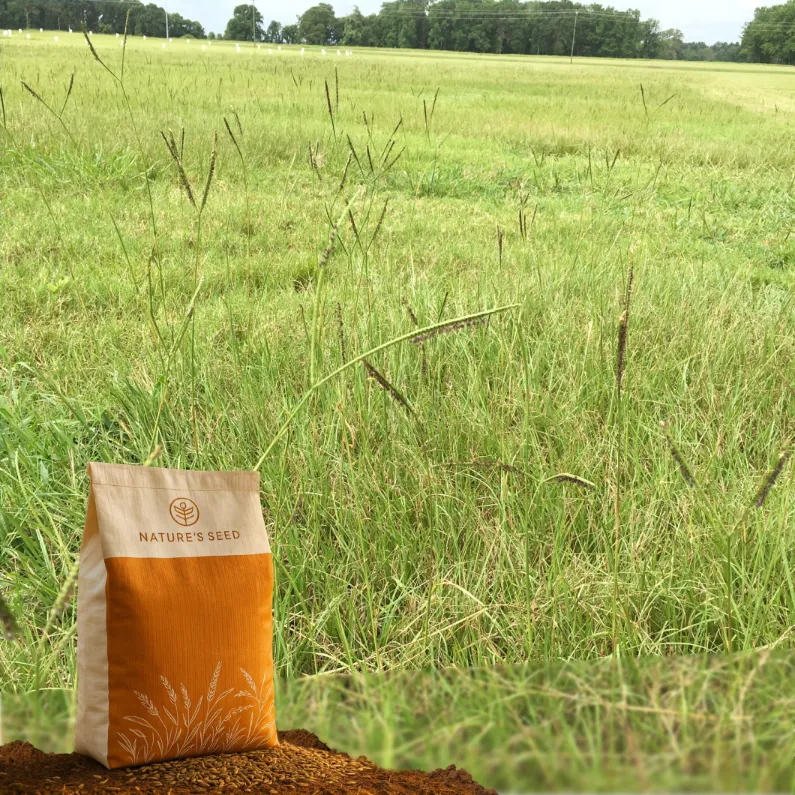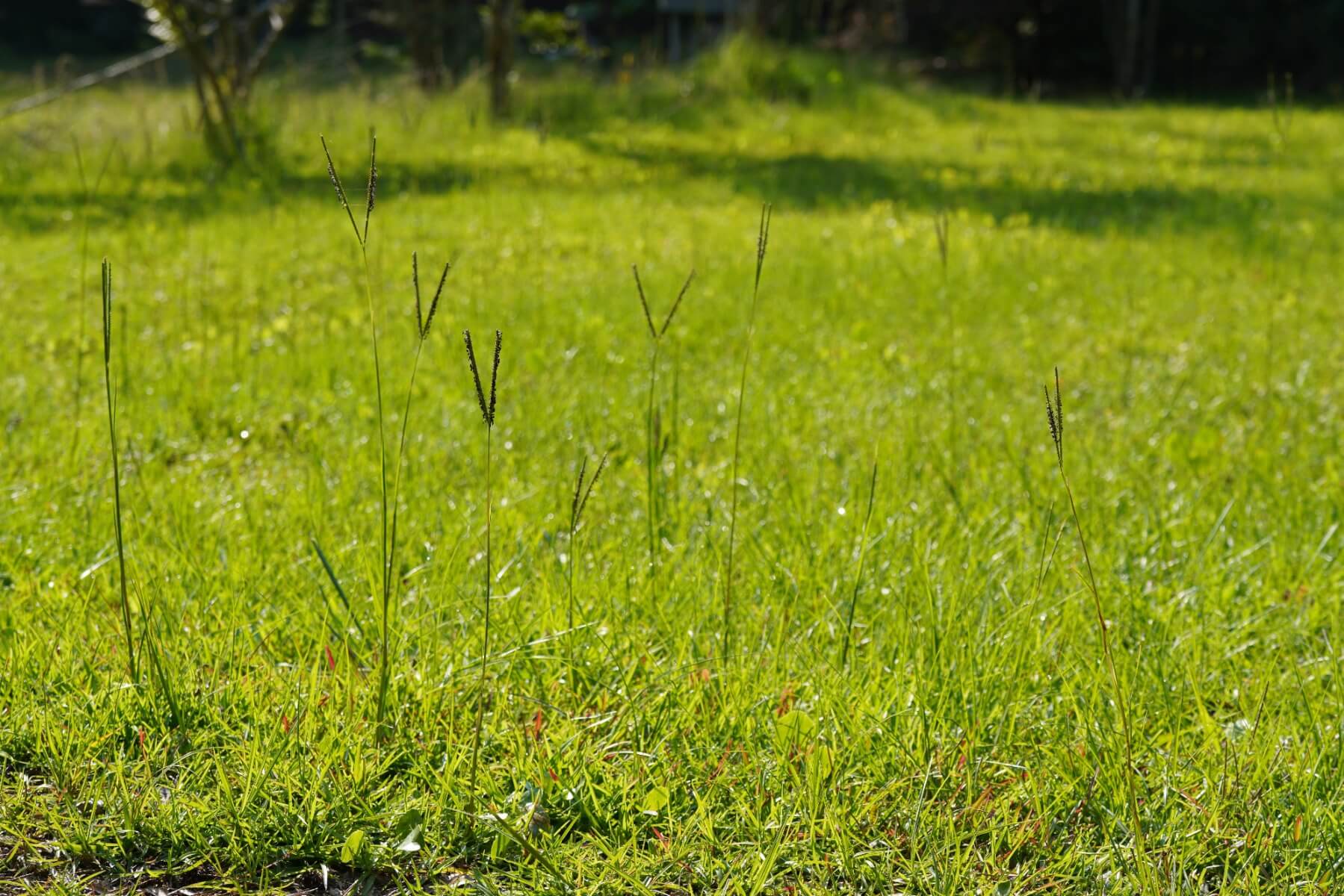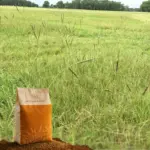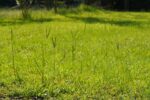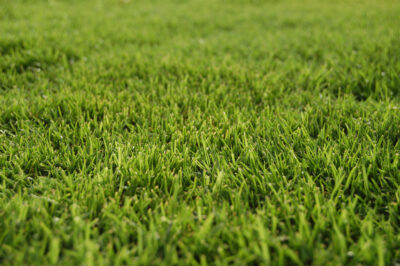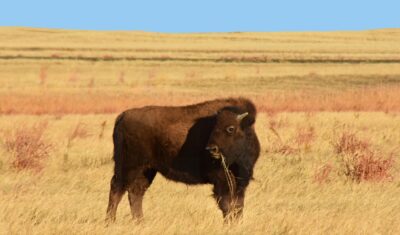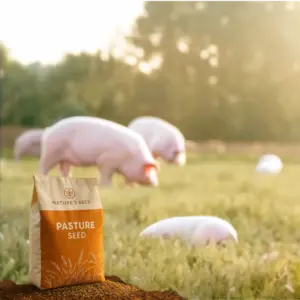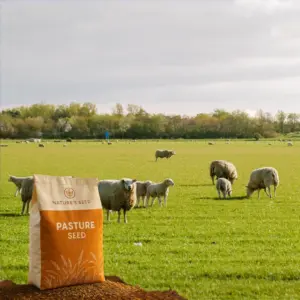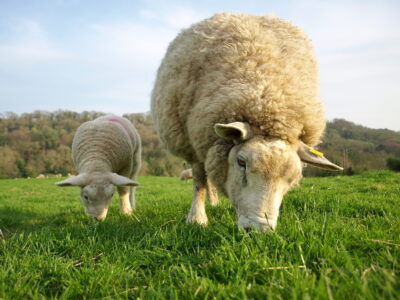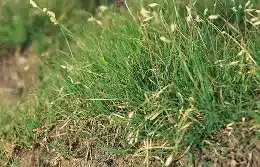What is Bahia Grass?
Specifications
Sun Requirement
Full sun
Soil Preference
extremely drought-tolerant
Soil pH
Adaptable – grows in sandy, loam or clay soils
Time to Maturity
~90 days
Height when mature
~12–25 inches
Seeding Rate
20 Lbs/Acre
Planting Depth
1/4 inch (cover seed lightly with soil)
Bahia Grass
Paspalum notatum | SKU: PG-PANO
- Cattle
- Poultry
- Sheep
- Goats
- Horse
- Bison
- Alpaca/Llama
Will the seed work for your area?
Check your region
select quantity
Description

Drought Performance
Bahiagrass has outstanding drought hardiness. It develops an extensive, deep root system that helps it withstand prolonged dry periods. In fact, this grass survives drought by going dormant (turning brown) and then greenes up quickly with rain. Its growth is even favored by droughty conditions, often outlasting other grasses when moisture is scarce. This makes Bahia Grass a reliable choice for regions prone to seasonal dryness or water restrictions.
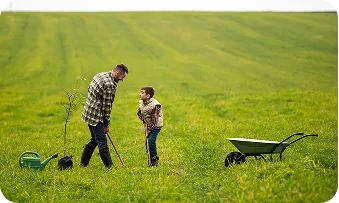
Low Maintenance
One of Bahia’s biggest advantages is how little pampering it needs. It thrives in infertile, sandy, or acidic soils where many other grasses struggle. Bahiagrass requires minimal fertilizer to maintain a healthy stand – yet it will respond with greater yield if given nutrients. It also has few serious pests or diseases in the U.S, so it generally stays healthy without intensive care. Homeowners love that it doesn’t form thick thatch and can get by with limited watering and mowing
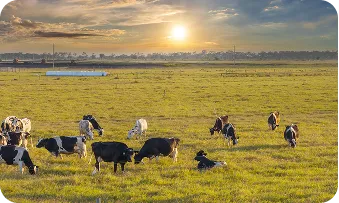
Grazing Resilience
Bahiagrass is a workhorse forage grass for pastures. It was originally introduced to Florida in 1913 specifically as a pasture grass and for soil protection. It endures heavy grazing pressure and hoof traffic without losing stand density, provided it’s not grazed into the ground constantly. Ranchers appreciate that Bahia can be grazed closely – it tolerates “close cropping” better than many grasses. For best results, managers keep pasture height in the 2–6 inch range to maintain nutritional quality. While its forage quality is moderate (lower digestibility than bermudagrass), Bahia grass will persist where higher-maintenance grasses would decline, ensuring consistent grazing throughout summer. Its ease of establishment from seed and persistence under low input make it a staple for cow-calf operations on the Gulf Coast.
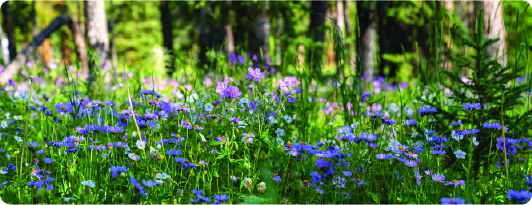
Compatibility with Wildflowers
Unlike some sod grasses, bahiagrass does not form a super-dense carpet, which means other plants can intermingle with it. Its open canopy and relatively upright growing habit allow wildflowers or legumes to emerge through the grass in season. Land managers often overseed bahiagrass pastures with clover or winter annual grasses to extend grazing seasons and add diversity. Similarly, you can include Bahia in a native wildflower meadow (especially in the Southeast) at low seeding rates – it will act as a green backdrop and soil stabilizer, while wildflowers add color and pollinator value. This grass plays well with others when managed, making it useful for naturalized plantings.
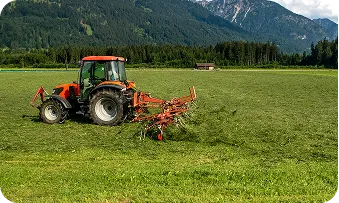
Ornamental Appeal
While bahiagrass is not a manicured lawn grass, it has a certain rustic charm in landscapes. Its distinctive “Y”-shaped seed heads stand tall above the foliage, giving a meadow-like appearance. The grass blades are a medium to light green color and stay lush through the heat of summer when cool-season lawns have browned out. Bahiagrass works well for large rural yards, roadside strips, or open fields where a natural, low-maintenance look is desired. It can be mowed a few times a season to keep the seed stalks in check, or left longer for a waving prairie aesthetic. In ornamental plantings, Bahia grass provides a hardy green filler that highlights wildflowers or shrubs, and its ability to thrive without pampering means you’ll have a resilient green cover all season long.
Description
Detail Product
Sun/Shade
Full sun
Height
~12–25 inches
Seeding Rate
20 Lbs/Acre
Uses
Pasture grazing, hay production, erosion control on slopes & roadsides, low-water lawns, and conservation plantings
Color
Light green foliage in spring and summer; produces black/brown “Y”-shaped seed heads.
Water
Light green foliage in spring and summer; produces black/brown “Y”-shaped seed heads.
Native
introduced
Life Form
Perennial grass
Product Uses
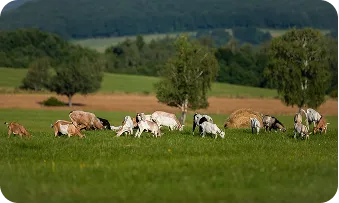
Forage & Grazing
Bahiagrass is a cornerstone of Southern pastures. It provides reliable grazing for cattle, horses, and other livestock during the warm months. Ranchers seed Bahia for its persistent forage that can handle continuous grazing and still come back year after year. While its nutritional quality is moderate, it responds well to managed grazing – keeping the grass in a short, vegetative state (about 3–6 inches tall) yields the best protein and digestibility. Many farmers also cut Bahia for hay, especially in regions like Florida and Alabama, valuing its easy establishment and low upkeep for hayfields (though Bermuda grass hay is higher quality). Overall, Bahia’s toughness under grazing and ability to grow in poor soils make it a dependable forage base in the Southeast.
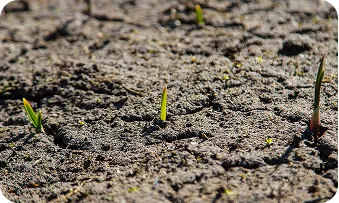
Erosion Control
Bahiagrass is an erosion control champion. Its thick sod and far-reaching roots lock soil in place on slopes, embankments, and waterways. Conservationists and highway departments use Bahia Grass to stabilize roadsides, ditches, and strip-mined areas where loose soil would otherwise wash out. It establishes a permanent cover that tolerates harsh conditions – from drought on sunny highway shoulders to periodic flooding in drainage swales. Once grown in, bahiagrass requires little maintenance, so it’s ideal for remote or difficult-to-access areas. By sowing this grass on vulnerable ground, you can prevent erosion and runoff, protecting both the landscape and water quality.
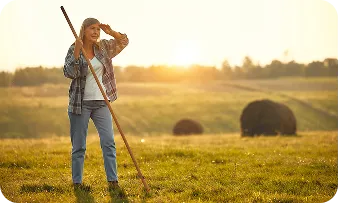
Low-Maintenance Landscaping
For large properties, rural lawns, or any spot where you want green groundcover without the fuss, bahiagrass is a top choice. It excels in low-input lawns – those without irrigation systems or regular fertilization. In the Deep South, many homeowners use Bahia for big acreage lawns, horse pastures doubling as lawn, or utility areas. It won’t give a golf-course carpet look, but it will stay green through heat and survive on rainfall alone in most years. Bahiagrass only needs occasional mowing (primarily to cut off the tall seed stalks for a neater appearance). Its open-growth habit means it doesn’t develop heavy thatch, and it recovers well if neglected. If you’re tired of watering and babying grass, Bahia offers a simpler, hardy lawn alternative that retains a natural, meadow-like beauty.
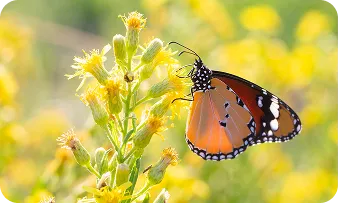
Wildlife Habitat
Bahia Grass can play a role in enhancing wildlife habitat on your land. Its moderate height and clump-forming nature provide cover for creatures like rabbits and ground-nesting birds. The seeds that form on its unique Y-shaped spikes serve as food for wildlife – quail and doves, for instance, will feed on the fallen seeds. Deer have been known to graze on young bahiagrass and also nibble seedheads. If you’re managing a property for wildlife, Bahia grass can be a part of the mix by offering a low-maintenance cover that sustains wildlife between mast or food plot seasons. It’s often used in reclamation mixes for habitat restoration where quick soil stabilization and vegetative cover are needed, thereby jump-starting an area for wildlife use.
Ornamental Appeal
Although primarily a utility grass, bahiagrass can be appreciated in naturalistic landscaping for its textural and seasonal interest. The tall, forked seed heads that emerge in summer give a whimsical, prairie-like look that some gardeners enjoy in wildflower meadows or along fence lines. In wild gardens or coastal-themed landscapes, Bahia’s light-green, coarse blades convey a sense of the Old Florida prairie. It pairs well with wildflowers and native bunchgrasses – acting as a verdant backdrop that makes wildflower blooms pop. Because it thrives on neglect, you can use it in areas where ornamental grasses or turf might fail: hot roadside verges, sandy beachfront lots, or around rustic vacation cabins. Bahiagrass will dutifully fill in open ground with greenery, swaying seed spikes in the breeze, lending a relaxed, natural charm to large landscape areas.
Questions & Answers
What is Bahia Grass, and why do people plant it?
Bahia Grass is a warm-season perennial grass originally native to South America and introduced to the U.S. in the early 1900s. It’s popular in the Southeast for its toughness and versatility. People plant bahiagrass because it tolerates drought, poor soils, and heavy grazing better than many other grasses. It forms a low-maintenance sod that’s useful for pastures, roadside erosion control, and large lawns where you want reliable green cover without intensive upkeep. In short, it’s a hardy, “plant-it-and-forget-it” grass that provides functional groundcover and forage where more delicate grasses would fail.
Is Bahia Grass good for cattle and horses to graze?
Yes, bahiagrass is widely used as a pasture grass for cattle and horses. It’s valued in beef cattle operations (especially cow-calf farms) for its ability to withstand grazing pressure and continue to produce forage under low inputs. Horses can graze Bahia as well – in fact, many horse pastures in Florida and the Gulf Coast are Bahia grass. The grass isn’t as lush or high-nutrient as some improved pasture grasses, but it provides steady, adequate feed (about 7–12% crude protein typically). To get the best grazing results, it’s recommended to keep Bahia grass pastures trimmed or rotationally grazed so the grass stays young and leafy (tall, mature Bahia becomes stemmy and lower in nutrition). Overall, it’s a solid grazing grass – hardy and forgiving, though farmers sometimes supplement with protein feed or overseed legumes to boost nutrition for livestock on Bahia pastures.
How do I plant Bahia Grass seed, and how long does it take to establish?
Planting Bahia grass from seed is straightforward. The best time to sow is spring through early summer, once soil temperatures are warm and spring rains can help with establishment. Prepare a clean, firm seedbed (or you can overseed into existing sparse turf if controlling weeds). Sow the seeds at about 15–20 lbs per acre (or ~5–10 lbs per 1,000 sq. ft for lawns) and rake or press them into the soil at 1/4 inch depth – they need to be shallowly covered. Bahia grass is known for slow germination, so be patient. You might see the first sprouts in 2–3 weeks, but it can take 6–8 weeks for full coverage to really fill in. Warm weather and consistent moisture will speed it up, whereas dry conditions can prolong establishment. Within about 3 months of planting you should have a good young sod forming. Just keep those first 2–3 months relatively weed-free (mow or hand pull weeds) so the baby grass isn’t overtaken while it’s getting started.
What kind of upkeep or management does Bahia Grass require (fertilizing, mowing, etc.)?
One reason people love Bahia grass is that it doesn’t ask for much. It can get by with very little fertilizer, though it will respond positively if you feed it. Many pasture managers apply a moderate dose of nitrogen in spring and perhaps mid-summer to boost growth, but in a pinch Bahia will survive on low fertility. Soil pH in the 5.5–6.5 range is idea; if your soil is extremely acidic you might add lime occasionally. As for mowing or grazing management, Bahia tolerates close cropping but it’s best to maintain a few inches of stubble. For pastures, don’t graze or mow it down to bare ground – leaving ~3 inches (up to 5–6 inches in continuously grazed fields) helps the grass regrow healthier. In lawns, you might mow once every 2-4 weeks in the growing season, mainly to cut the tall seed stems for appearance. Keep mower blades high (3–4 inches) for a lawn. Bahia doesn’t produce heavy thatch, and it has few pest problems, so routine maintenance is minimal. One thing to note: if using it as a lawn, you may need to edge or remove occasional clumps that spread beyond desired areas, since Bahia can creep with its rhizomes. Overall, it’s a low-input grass – moderate mowing, infrequent feeding, and it happily grows with little attention.
Where will Bahia Grass grow in the U.S.? What regions or climates is it best suited for?
Bahiagrass is best adapted to the warm, humid regions of the United States. It absolutely thrives in the Deep South – think the Gulf Coast and Coastal Plain from eastern Texas across Louisiana, Mississippi, Alabama, Georgia, Florida and up into the Carolinas. It can grow as far north as parts of Arkansas, southern Tennessee, and the coastal Carolinas, although cold winters will make it go dormant and it might thin out at the northern edge of its range. In terms of USDA Hardiness Zones, it’s generally reliable in roughly Zone 7 and warmer. It’s a true warm-season grass, so it loves hot summers and mild winters. It is not suitable for cold northern climates – freeze temperatures in Zone 6 or below will kill it or prevent it from lasting as a perennial. Outside of the Southeast, you might see Bahia grass in pockets of southern California or the southwest if irrigated, and it’s also used in Hawaii (similar tropical climate). But in dry desert areas it would need water to establish. Essentially, Bahia grass will do best in places where summers are long and hot, and annual rainfall is moderate to high. If you’re in the Southeast or warm coastal West, it could be a great grass for you. If you’re in a northern state or high-elevation area with harsh winters, Bahia grass wouldn’t survive the cold – you’d be better off with a cool-season grass in those regions. In summary: stick to the Southeastern U.S. and other frost-free or mild winter areas for Bahia grass, and it will reward you with hardy growth and longevity
Still have
questions?
Our planting experts
are here to help.
Call Us
1-800-123-4567
8 AM–5 PM
Monday–Friday
Reviews
| Weight | N/A |
|---|---|
| Dimensions | 1 in |
| Sun/Shade | |
| Est Rate | |
| Height |
1' – 3' |
| Seeding Rate | |
| Uses | , , , , , |
| Color | , , |
| Water | |
| Native | |
| Life Form | |
| Lowest price | |
| Pounds | , , , , |
